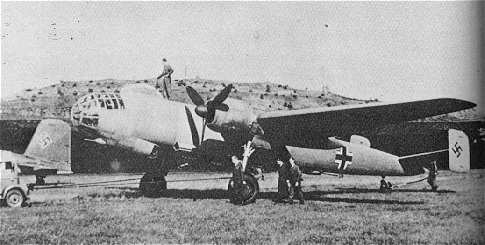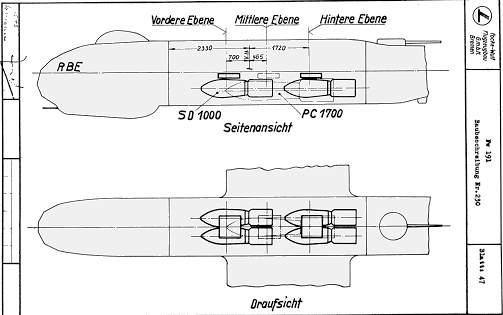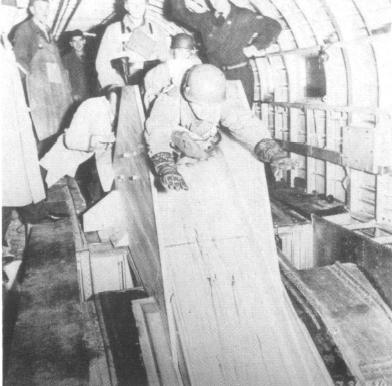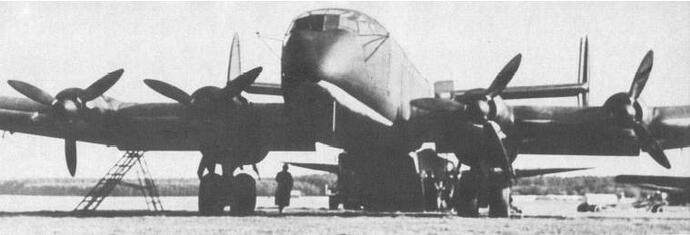The Ju-88 wasnt bad divebombing, the problem come when some idiot want that a plane big and heavy as He-177 should have the divebombing abilities…crazy.
And yes the lack of a devoted 4 engined aircraft put an incredible strain in several 2 engines designs like the “B” bombers.
Focke Wulf FW 191:

In July 1939 the RLM issued a specification for a new medium bomber. It was to have a maximum speed of 600 km/h (373 mph) and be able to carry a bomb load of 4000 kg (8820 lbs) to any part of Britain from bases in France or Norway. Furthermore, the new bomber was to have a pressurized crew compartment, remote control armament and was to utilize two of the new 2500 horsepower class of engines then being developed (Jumo 222 or Daimler Benz DB 604). This was the “Bomber B” program, which Arado, Dornier, Focke-Wulf and Junkers participated in. The Arado Ar E.340 was eliminated, the Dornier Do 317 was put on a low-priority development contract; and the Junkers Ju 288 and Focke-Wulf Fw 191 were chosen for full development.

Dipl. Ing E. Kösel, who also worked on the Fw 189 reconnaissance plane, led the design team for the Fw 191. Overall, the Fw 191 was a clean, all metal aircraft that featured a shoulder mounted wing. Two 24 cylinder Jumo 222 engines (which showed more promise than the DB 604 engines) were mounted in nacelles on the wings. An interesting feature was the inclusion of the Multhopp-Klappe, an ingenious form of combined landing flap and dive brake, which was developed by Hans Multhopp. The entire fuel supply was carried in five tanks located above the internal bomb bay, and in two tanks in the wing between the engine nacelles and fuselage.
The tail section was of a twin fins and rudders design, with the tailplane having a small amount of dihedral. The main landing gear retracted to the rear and rotated 90 degrees to lie flat in each engine nacelle. Also, the tailwheel retracted forwards into the fuselage. A crew of four sat in the pressurized cockpit, and a large Plexiglas dome was provided for the navigator; also the radio operator could use this dome to aim the remote controlled rear guns.

Armament was to consist of a remote controlled chin turret (two MG 81 7.9mm machine guns), a similar turret in the rear of each engine nacelle, an upper and lower turret featuring a single MG 151/20 20mm cannon and two MG 131 13mm machine guns.
Problems arose almost immediately when the Jumo 222 engines were not ready in time for the first flight tests, so a pair of 1600 horsepower BMW 801MA radial engines were fitted. This made the FW 191 V1 seriously underpowered. Another problem arose with the RLM’s insistence that all systems that would normally be hydraulic or mechanically activated should be operated by electric motors.
The installation of so many electric motors and wiring led to the nickname for the Fw 191 of “Das fliegende Kraftwerk” (the flying powerstation)! This also had the detrimental effect of adding even more weight to the overburdened airframe, plus there was also the danger of a single enemy bullet putting every system out of action if the generator was hit.
Dipl. Ing Melhorn took the Fw 191 V1 on its maiden flight early in 1942, with immediate problems arising from the lower rated engines not providing enough power, as was anticipated. One surprising problem that was encountered were the Multhopp-Klappe, which presented severe flutter problems when extended, and pointed to the need for a redesign. At this point, only dummy gun installations were fitted and no bomb load was carried. After completing ten test flights, the Fw 191 V1 was joined by the similar V2 , but only a total of ten hours of test flight time was logged.
At this point, the RLM allowed the redesign and removal of the electric motors (to be replaced by the standard hydraulics), so the Fw 191 V3, V4 and V5 were abandoned. The Fw 191 V6 was then modified to the new design, and also a pair of specially prepared Jumo 222 engines were fitted that developed 2200 horsepower for takeoff. The first flight of the new Fw 191 took place in December 1942 with Flugkapitän Hans Sander at the controls. Although the V6 flew better, the Jumo 222 were still not producing their design power, and the whole Jumo 222 development prospect was looking bad due to the shortage of special metals for it. The Fw 191 V6 was to have been the prototype for the Fw 191A series
Since the Jumo 222 engines were having a lot of teething problems, and the Daimler Benz DB 604 had already been abandoned, a new proposal was put forth for the Fw 191B series.
The V7 through V12 machines were abandoned in favor of using the Fw 191 V13 to install a pair of Daimler Benz DB 606 or 610 engines, which were basically coupled pairs of either DB 601 or 605 12 cylinder engines. Their lower power-to-weight ratio, however, meant that the armament and payload would have to be reduced. It had already been decided to delete the engine nacelle gun turrets, and to make the rest manually operated. Five more prototypes were planned with the new engine arrangement, V14 through V18, but none were ever built.
One final attempt was made to save the Fw 191 program, this time the Fw 191C was proposed as a four engined aircraft, using either the 1340 horsepower Jumo 211F, the 1300 horsepower DB 601E, the 1475 horsepower DB 605A or the 1475 horsepower DB 628 engines. Also, the cabin would be unpressurized and the guns manually operated; a rear step in the bottom of the deepened fuselage being provided for the gunner.
Unfortunately, at this time, the whole “Bomber B” program had been canceled, due mainly to no engines of the 2500 horsepower class being available, which was one of the primary requirements in the “Bomber B” program. Although the Fw 191 will be remembered as a failure, the air frame and overall design eventually proved themselves to be sound, only the underpowered engines and insistence on electric motors to operate all the systems eventually dooming the aircraft. All in all, there were only three Fw 191s ever built (V1, V2 and V6), and no examples of the Fw 191B or C ever advanced past the design stage.
Type: Advanced Medium Bomber
Origin: Focke-Wulf Flugzeugbau GmbH.
Models: V1 to V6, A, B, & C
First Flight: Early 1942
Service Delivery: Not put into production
Final Delivery: N/A Engine: See comments
Horsepower: N/A
Fuel:
Capacity: N/A
Type: N/A
Dimensions:
Wing span: 26.00m (85 ft. 3.5 in.)
Length: 19.63m (64 ft. 4.75 in.)
Height: 5.60m (18 ft. 4.5in.)
Weights: (B Model)
Empty: 16,300kg (35,940 lbs.)
Maximum: 25,600kg (56,445 lbs.) Armament:
Planned Armament:
Dorsal and ventral barbettes, each with a 20mm MG 151 cannon flanked by two 7.92mm MG 81, Two twin MG 81 barbettes in the tail of the engine nacelles, and a chin barbette with another pair of MG 81.
Bomb Load:
4000 kg
(Two torpedoes could also be carried internally)

www.luft46.com
www.warbirdsresoursegroup.com




















 [/LEFT]
[/LEFT]










